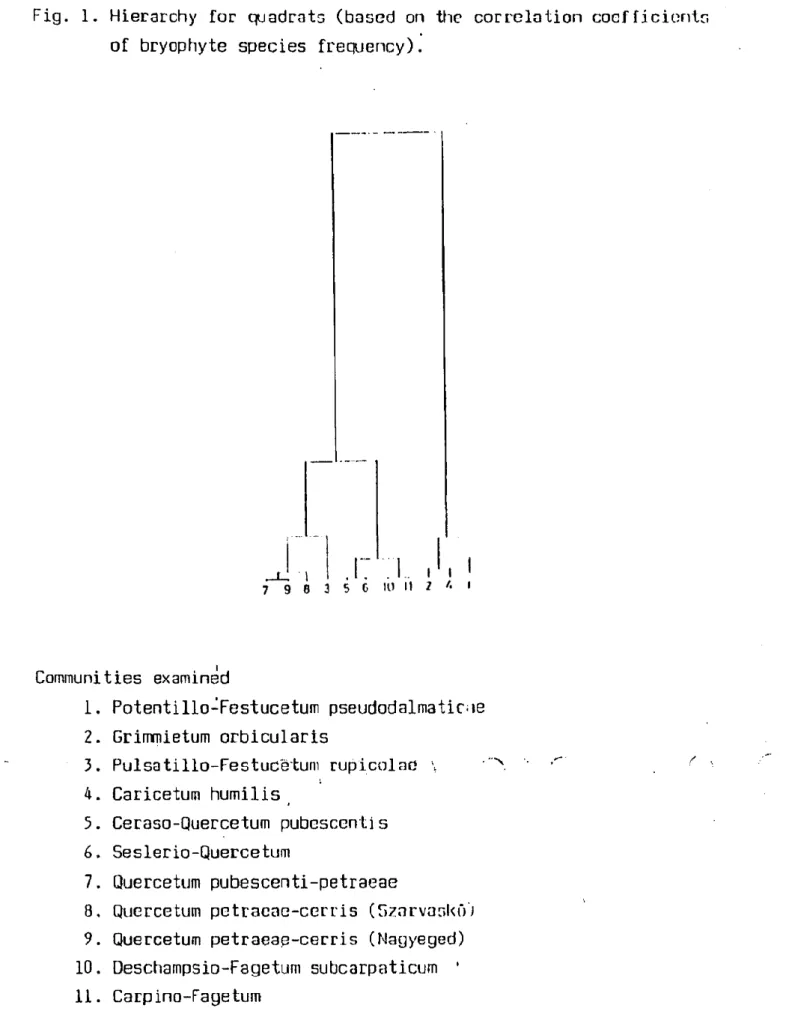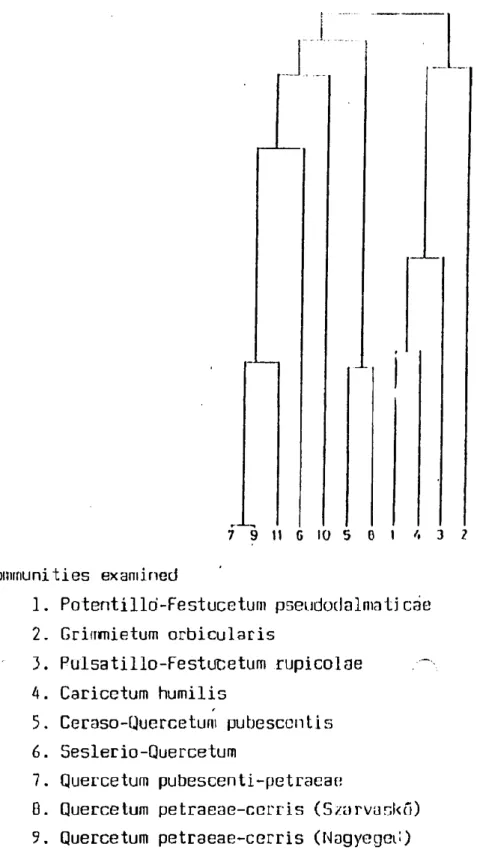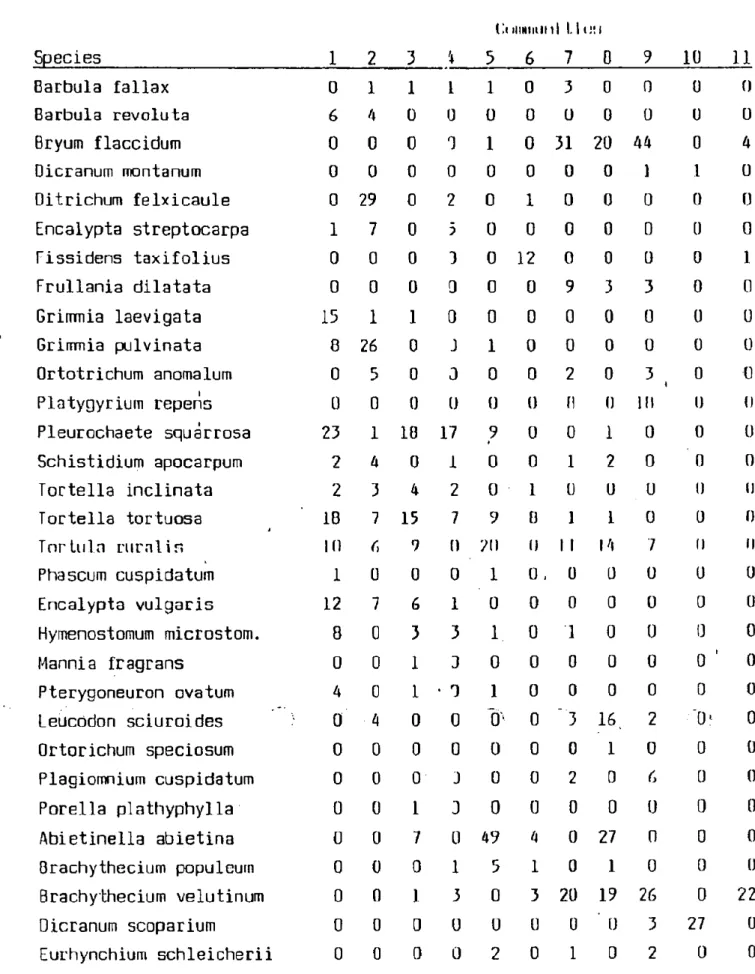- 197 -
SÁNDOR ü r bAn
A N A L Y S I S O F SOMÉ P L Á N T m W U N t T I E S B A 5 E Ö ON 1 1 IL Í3 R Y O P IIY IE L A Y T R
AÖ51RACT: The floristic composition of 11 plánt comitunitios was exnmined by cluster analysis based on the frectiency and life strategies of bryophytes. The dendrograms based on floristic and life strategy data show that the bryophyte layers of grassy and woody communities nce different. On the other hand, the brynphyte flóra and the strategy spectrum of ecologically similar communities closuly ngrec.
INTRODUCTIÜN
The project "The ecological and coenulogical eonuoetions ni tlu: lile strategies of bryophytes" is sponsored by the Hungárián Acndemy oí Sciences. The prcsent paper givus somé cnouolngieal ier.nl Is cd' Utr; ahnve mentioned investigations.
It is documented by previous studies that ti le bryophytes are useíul indicators of the environment in which they are present (Zólyomi 1931, Boros 1968, Benson-Evans 1961, Barkman 195B, Gimingham-Oirse 1957, Simon 1970, Simon— Szerényi 1975, Slack 1977, Orbán 1904, 1907), and résül Is are more exact if the investigations are trade on the hasis of the life strategies of bryophytes occurring in the communities (Orbán 1904 a, b ) . Fór the analysis of vegetation types a freguently used method is cluster analysis (see, e.g. Feoli--Ganis 1985, Feoli— Orlóci— Scimone 1905, Podani 1905, etc.). In the bryological rcsonrch this ne Utód is cmployed fór taxonomical investigations (e.g., Dűli— Hertnanns and Dűli 1985, etc.), bút analyses of vegetation types were alsó made by the author (Orbán 1984). Results of the latter investigations showed that the
- 198 -
communitios are separable and comparable on the hasis of Iheir bryophyte layer.
MLIIIUU5
The sampling areas were chosen in the Uükk Mis. lliey arc: Mt.
Nagy-Eged, Mt. Csákpilis near Felsötárkány and 'Mt. Keselyűdére near Szarvaskő. The Ceraso-Quercetum pubescentis, Quercetum pubesoentis- petraeae, Quercetum petraeae-cerris and Carpino-Fagetum cummunities were examined in Mt. Nagy-Eged (see Table 1, Nos 5, 7, 9 and 11). Comniunities Pulsatillo-Festucetum rupicolae, Potentilio-Festucetum pseudodalmaticae and Quercetum petraeae-cerris were examined near Szarvaskő (see Table 1,
Nos 3, 1 and 8). ,
The Seslerio-Quercetum, Seslerio-Querscetum caricetosum humilis, Deschampsio-Fagetum and Grimmietum orbiculnris communilius were
investigated in Mt. Csákpilis. The nomenclature of comniunities follows
Soó (1964). .
Fifty sample plots of 10 x 10 cm arei were cnllected randomly jn
2
each of the above mentionod communities. All bryn)ihyfo species were collected which occurred in the sample plot. Ilié 50 randomly takúri [dols are enough fór the collection of all bryophyte species which represent the communities.
The bryophytes were identified accordinr to the Handbook of Hungárián Bryoflora (Orbán— Vajda 1983). After identification, the feregucncy and life strategies of species were recognized. The life strategy categories are those used by During (1979) and the life strategy types of species were recognized according to Orbán (1984).
Table 1 contains the freguency data of bryophyte species which occur in the communities examined and Table 2 includes the frequency scores of life strategies.
- 199 -
Cluster analysis wasusod Tor the cnmpnrtson ni Ilin Iii ynphyIn Inyer oí communities. The CLAN program was üevelopeü by 1. Pergő Linnéd on Podnni's (1900) pnper and wnr. run un íi Prtipor U1 computer. Ilin sűrűiig algorithms used are furthest neighbaur (complete linkage) and sum of squares agglomeration. The similarity mntrices vaj re cn Lóul a led bar,ed un Ihe correlation coefficients oT lrequency of species and lile slralégiós
of bryophytes. .
RESULTS AMD DISCUSSIUN
It seems írom Table 1 that all commui .ities have somé very frequent species. In the Potentillo-Festucetum pseudodalmaticae community Pleurochaete squarrosa, Tortella tortuosa and Grimmia laevigata are frequent. In the Grimmietum orbicularis üitrichum flexicaule and Griinnia pulvinata var. africana, and in the S-Q caricetosum Lnnnilis community Pleurochaete squarrosa, in the Ccraso-Quercetum [mbencentis Abinlinolla abietina, Homalothecium lutescens and Rhytidium rugosuin are the most frequent. Bryum flaccidum Pylaisia polynntha, Brnchythecium veluj.inum Leucodon sciuroides and llypnum cupressi lurme are Irequonl in IJuereotum petraeae-cerris. In the Deschampsio-Fagetum beeehwood Leucobryum glaiicum and Dicranum scoparium are frequent, and in the Cnrp inn-rngol.nm Brachythecium velutinum is the most common.
It seems that noticeable differences arc belweon, Ihe species composition of communities examined. The dendrogram (Fig. 1) based on the frequency of species shows very well which communities are similar according tö their bryophyte composition and which are different írom this point of view. The grassy (No 1, 2, 3, A) and woody communities are well separated írom each other in the denilrogram. Ihe most similar communities are the oakwoods, e. g., Quercelum pubescentis-petraeae, Quercetum petraeare-cerris and Ceraso-Uuercetum pubescentis. Among the grassy communities the Seslerio-Quercetum caricetosum Immilis and the Potentillo-Festuce.tum pseudodalma ticae are very similar. The other communities are t significantly different írom the above mentionod communities. The beechwoods came to another branch in the dendrogram, and
- 200 -
it is very interesting that the Carpino-Fagetum and Oeschampsio-Fagetnm are alsó different from each other (F j 10, 11). The Grimtnietnm orbiculnris (No. 2) is alsó on n unparotód brnnch. Ilii:; i:iiiihihíi• 1 l.y neeurs on the surface of dolomité rocks, where the vascular plants are very scarce or absent, so the floristic-31 composition of brynphyte layer is very different from other communities.
The analysis was alsó madc; on the hasis of lile slral.eijios cd bryophytes (see Table 2 and Fig. 2.) Table 2 contains the frequency of life strategies of bryophytes. It is very interesting that the sirijilar communities which belong together are separated well from the other communities. So it seems that there are three groups of communities: the first one contains the oakwoods, the socond one contains the opened oakwoods and the beechwood communities and the third group includes the grassy communities. It is interesting that the bryophyte layer of Pulsatillo-Festucetum rupicolae is sini.ilnr to the bryophyl.o layer of oakwoods (No. 3, 7, 0, 9). Probably the canopy closure of grass species has a similar effect on bryophytes as the canopy of oakwood communitios.
The above mentioned results support our previous findinys (Orbán 19B4). Since the grass Ínyei: of Ilin l.wo opened woody nmmiuni I.ies (e.t|., Ceraso-Quercetum, No. 3, and Seslerio-Oiurcetum, No. 6) is closed and gives strong shade fór mosses, the similar .ty in the composition of the life strategies of bryophytes of beechwood cummunilies is undorslood Nos
10, 11) .
The third group is separated sharply frotír the above mentioned. two groups because they are the opened grassy communities. The similarity of the three communities is cau.sed by the low abundance of vaséul a r plants, so in these communities the species of colonist strategy type are frequent. On the other hand, the perennial stayers are more frequent in the woody communities.
- 201 -
CONCLUSÍDNS
it has bucii luund Ihat the bryophyte Ilm a ni plánt emumon i I.ies ir;
determined by the composition of coenoses and the degroe nf canopy closure. According to this fact the operiod and closed grnsy nnmmini l.ies, the opened and closed woody communities and their bryuphyte lnyer are very different in floristic and life strategy composition. ön the hasis of life strategies, it seeins that the bryophyln layer nf clorjod grassy communities is closely related to the w:iody communities. However, the floristic composition is very different fron each other. In closed grassy communities and in woody communities the perennial stayer species are very frequent, bút we can found Rhytidium rugosum and Abietinella abietina in grassy communities. On the ot er liand, in woody commuoi tios Hypnum cupressiforme, Brachythecium velutL.um and Pylaisia pólyánIha are very common.
It is a very’interesting tendency thal in opened grassy communities the proportion of the species of colonist strategy is Iargon thnn nthei strategy types. However, in closed grassy communities, iu opened and closed woody communities the proportion of the species of perennial stayer strategy will he mnre and űrire larger (soe Fahln 2).
Cluster analysis based on life strategies of bryophytes is suitnble to the separation of plánt communities, a id mákos the Identification of the related groups of communities possible.
- 202
REFERENCES
Bnrkmnn, 0. 0. (1950): Phytosnoinlnyy :iml oonloyy ul' i:iy|il.ny;iinli:
epiphytes. - Assen.
Benson-Evans, K. (1961): Environmontnl fnctors árul bryophytes. - Malmö, London, 191:255-260.
Boros, A. (196B): Bryogeographie und Bryoflora Ungarns. - Akadémiai Kiadó, Budapest
Düll-Hermanns, I. and Dűli, R. (1985): Taxonomical re-investigation of eight critical European taxa of the genus Didymodon. - Abstracta Bot. 9. Suppl. 2:33-45.
During, H. J. (1979): Life strategies of bryophytes: a preliminary review. - Lindbergia 5:2-18.
Feoli, E. and Ganip, P. (1985): Coinparison of floristic vege lation types by multiway contidgency tables. - Abstracta Bot. 9:1-17.
Feoli, E. — Orlóci, L. — Scimone, M. (190'-): Monsuriug r.t motorai convergence of vegetation types on the basis of floristic dala.
- Abstracta Bot. 9:17-33.
Gimingham, C. H. -- Birse-, E. M. (1957): Eculnyicat stúdiós on yrnwlh- form in bryophytes I. - J. Ecol. 45:5)3-545.
Orbán, S. — Vajda, L. (1903): Magyarország unhat Iórájának kó/i könyve.
- Akadémaiai Kiadó, Bp.
Orbán, S. (1984): A magyarországi mohák stratégiáinak ökológiai és cönológiai összefüggései. Kandidátusi ért. (kézirat)
Orbán, S. (1984): A magyarországi mohák stratégiái és T, W, R értékei.
- Acta Acad. Pead. Agriensis 17:755-765. . , Podani, J. (1980): SYN-TAX: Számítógépes programcsomag cönológiai és
taxonómaiai osztályozások végrehajtására. - Abstracta Bot. 6:1-150.
Podani, 3. (1985): Syntaxonomic congrucnce in a small-scalc vege tolion survey. - Abstracta Bot. 9:99-129.
Simon, T. (1970): Bryocönológiai és ökológiai adatok a Zemplén-hegység- böl. - Bot. Közi. 57:31-43.
Simon, T. — Szerényi, G. (1975): Moss ecological investigation in the forest-steppe associations of the IBP-areo at Csévharaszt. - Acta Bot. Hung. 21:117-136.
- 203 -
Slack, N. G. (1977): Species diversity and cominum ty slructtire in bryophytes. - New York State Museum Bulletin 42(3:1-70.
Soó, R. (1964): A magyar flóra ós vegetáció rendszer tani - növénylöI rajzi kézikönyve I. - Akad. Kiadó, Bp.
Zólyomi, B. (1931): A Bükk liegység környókór,nk 5p!ingnom-lápjai . - lln Közi. 2B:89-121.
- 204 r
Fig. 1. Hierarchy fór quadrats (based on the corrclation coefficients
1. Potentillo-Festucetum pseudodalmaticoe 2. Grimmietum orbicularis
3. Pulsatillo-Festucé'tum rupicolae \ 4. Caricetum humilis
3. Ceraso-Quercetum pubescervtis 6. Seslerio-Quercetum
7. Quercetum pubescenti-petraeae
8. Quercetum petracae-cerris (Szarvaskő) 9. Quercetum petraeap-cerris (Nagyeged) 10. Deschampsio-Fagetum subcarpaticum ' 11. Carpino-Fagetum
of bryophyte species frequency).
Communities examined
- 205
Fig. 2. Hierarchy fór quadrats (based on the corrclation coefficient of the frequency of lile strategies of bryophy ter>).
Communities examined
1. Potentillo'-Festucetum pseudodalmaticae 2. Grimmietum orbicularis
3. Pulsatillo-Festucetum rupicolae . ~ 4. Caricetum humilis
5. Ceraso-Quercetum pubescentis 6. Seslerio-Quercetum
7. Quercetum pubescenti-petraeae
ö. Quercetum petracae-ccrris (Szarvaskő) 9. Quercetum petraeae-cerris (Nagyegeu) 10. Deschampsio-Fagetum subcnrpaticuin 11. Carpino-Fagetum
Table 1
Ci immun I L i i i
Species 1 2 3 4 5 6 7 B 9 10 11
Barbula fallax 0 1 1 1 1 0 3 0 0 0 0
Barbula revoluta 6 4 0 ü ü 0 U 0 0 0 ü
Bryum flaccidum 0 0 0 3 1 0 31 20 44 0 4
Dicranum montanum 0 0 0 0 0 0 0 0 1 1 0
Ditrichum felxicaule 0 29 0 2 0 1 0 0 0 0 0
Encalypta streptocarpa 1 7 0 3 0 0 0 0 0 0 0
Fissidens taxifolius 0 0 0 3 0 12 0 0 0 0 1
Frullania dilatata 0 0 0 0 0 0 9 3 3 0 0
Grimmia laevigata 15 1 1 0 0 0 0 0 0 0 0
Grimmia pulvinata 8 26 0 3 1 0 0 0 0 0 0
Ortotrichum anomalum 0 5 0 0 0 0 2 0 3 t 0 0
Platygyrium repens Ü 0 0 (J 0 0 fi 0 111 u 0
Pleurochaete squárrosa 23 1 18 17 9 0 0 1 0 0 0
Schistidium apocarpum 2 4 0 1 0 0 1 2 0 0 0
Tortella inclinata 2 3 4 2 0 1 ü 0 0 0 0
Tortella tortuosa ' 1B 7 15 7 9 0 1 1 0 0 0
Tnrluln rumlin 10 6 9 0 21) () 1 1 14 7 II II
Phascum cuspidatum 1 ü 0 0 1 0 , ü 0 0 0 0
Encalypta vulgáris 12 7 6 1 0 0 0 0 0 0 0
Hymenostomum microstom. 8 0 3 3 1. 0 1 0 0 0 0
Mannia fragrans 0 0 1 3 0 0 0 0 0 0 ' 0
Pterygoneuron ovatum 4 0 1 ■ 3 1 0 0 0 0 0 0
Leucödon sciuroides ■' 0 4 0 0 0' 0 "3 16, 2 0* 0
Ortorichum speciosum 0 0 0 0 0 0 0 1 0 0 0
Plagiomnium cuspidatum 0 0 0 3 0 0 2 0 6 0 0
Porella plathyphylla 0 0 1 3 0 0 0 0 0 0 0
Abietinella abietina 0 0 7 0 49 4 0 27 0 0 0
Brachythecium populeum 0 ü 0 1 5 1 0 1 0 0 0
Brachythecium velutinum 0 0 1 3 0 3 20 19 26 0 22
Dicranum scoparium 0 0 0 0 0 ü ü 0 3 27 0
Eurhynchium schleicherii 0 0 0 ü 2 0 1 0 2 0 0
- 207
Eurhynchium swartzii 0 0 0 0 0 0 0 0 0 0
Homalothecium lutescens 0 0 0 2 21 23 0 0 0 0
tlomalo ttiecium scricoum 0 3 0 0 0 u 0 1 (1 0
Hylocomium splendens 0 0 0 0 0 3 0 0 0 0
Hypnum cupressiforme 0 3 5 9 11 m 32 9 43 9
Hypnum vaucheri 0 16 0 1 0 í 0 0 0 0
Leskea polycarpa 0 0 0 0 0 0 9 7 7 0
Leskeella nervosa 0 0 0 0 0 0 2 1 2 0
Leucobryum glaucum 0 0 0 0 0 0 0 0 0 32
Lophocolea heterophylla 0 0 0 0 0 0 0 0 1 0
Paraleucobryum longifol. 0 0 0 P 0 0 0 0 0 6
Polytrichastrum formosum 0 0 0 0 0 0 0 ü 0 19
Pseudoleskeela catenul. 0 2 0 0 0 0 0 0 0 ‘ ü
Pylaisia polyantha 0 0 0 t 0 0 24 4 24 0
Rhodobryum ontariense 0 0 1 0 0 7 0 0 0 0
Rhy tidium rugosuin 7 ü 39 ü 21 l n 16 0 0
Thuidium recognitum Ü 0 0 0 0 24 0 ü 0 0
COMMtlNTTirS
1. Potentillo-Festucetum pseudodalma licac 2. Grimmietuin orbicularis
3. Pulsatillo-Festucetum rupicolae
4. Seslerio-Quercetum caricetosum humilis 3- Ceraso-Quercetum pubescentis
6. Seslerio-Quercetum
7. Quercetum pubescentis-petraeae
8. Querceturn petraeae-cerris (Szarvaskő) 9. Quercetum petraeae-cerris (Nagy-Eged) 10. Deschampsio-Fagetum subcarpaticum 11. Carpino-Fagetum
4 0 (J 0 9 0 0 0 u l 0 0 0 3 0 (I 0
- 208 -
Table 2.
Cmmuini t i c:n
S tntény 1 2 3 4 5 6 7 n 9 10 11
C 85 94 48 35 41 22 66 41 76 1 5
AS 1 0 0 0 1 0 U 0 0 0 0
SL 24 7 , 11 4 2 0 1 0 0 0 0
LS 0 4 , 1 0 0 0 5 17 8 0 0
P 7 24 54 16 111 85 103 87 110 93 44


